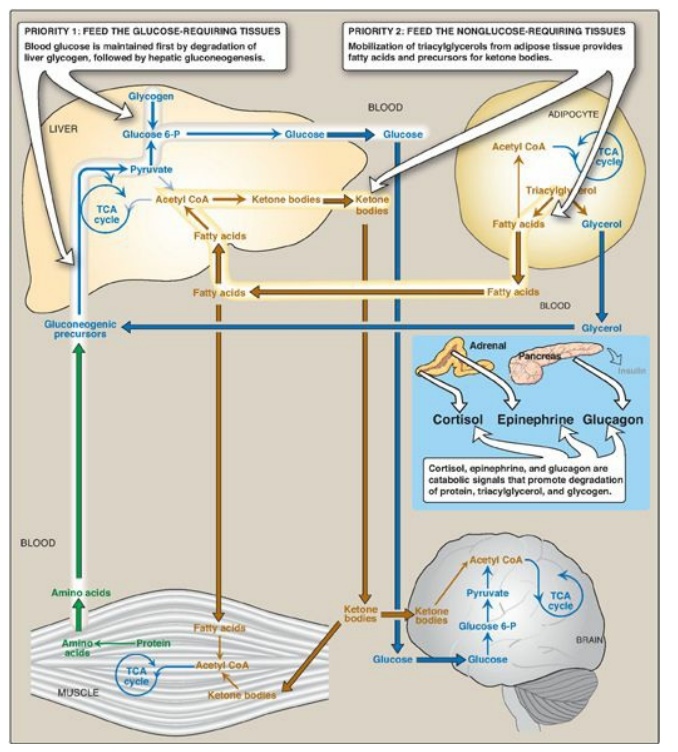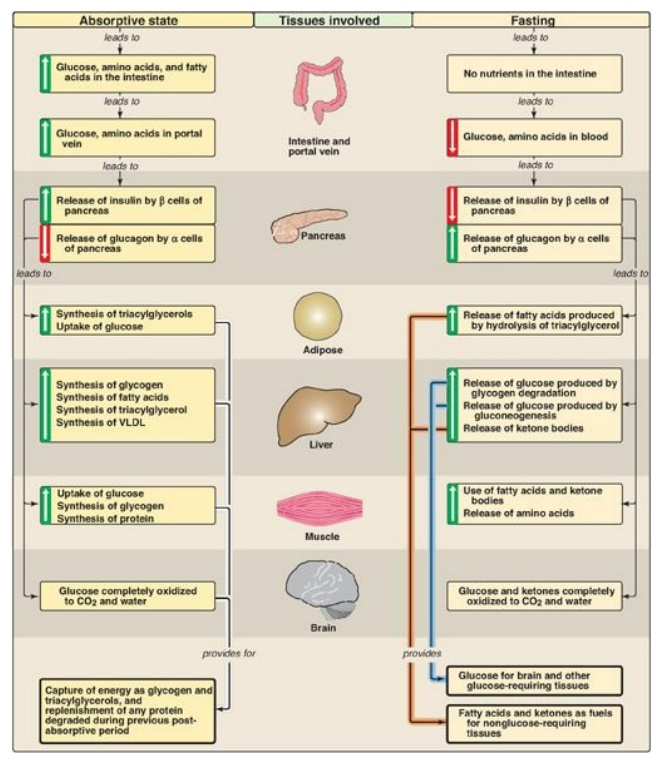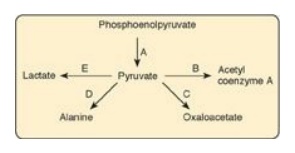Chapter Summary, Questions Answers - The Feed-Fast Cycle
| Home | | Biochemistry |Chapter: Biochemistry : The Feed-Fast Cycle
The flow of intermediates through metabolic pathways is controlled by four mechanisms: 1) the availability of substrates, 2) allosteric activation and inhibition of enzymes, 3) covalent modification of enzymes, and 4) induction-repression of enzyme synthesis.
CHAPTER SUMMARY
The flow of
intermediates through metabolic pathways is controlled by four mechanisms: 1)
the availability of substrates, 2) allosteric activation and inhibition of
enzymes, 3) covalent modification of enzymes, and 4) induction-repression of
enzyme synthesis. In the absorptive state, the 2–4-hour period after ingestion
of a meal, these regulatory mechanisms ensure that available nutrients are
captured as glycogen, triacylglycerol (TAG), and protein (Figure 24.20). During
this interval, transient increases in plasma glucose, amino acids, and TAG
occur, the last primarily as components of chylomicrons synthesized by the
intestinal mucosal cells. The pancreas responds to the elevated levels of
glucose with an increased secretion of insulin and a decreased secretion of
glucagon by the pancreas. The elevated insulin-to-glucagon ratio and the ready
availability of circulating substrates make the absorptive state an anabolic
period during which virtually all tissues use glucose as a fuel. In addition,
the liver replenishes its glycogen stores, replaces any needed hepatic
proteins, and increases TAG synthesis. The latter are packaged in
very-low-density lipoproteins, which are exported to the peripheral tissues.
Adipose tissue increases TAG synthesis and storage, whereas muscle increases
protein synthesis to replace protein degraded since the previous meal. In the
fed state, the brain uses glucose exclusively as a fuel. In the absence of
food, plasma levels of glucose, amino acids, and TAG fall, triggering a decline
in insulin secretion and an increase in glucagon and epinephrine release. The decreased
insulin/counterregulatory hormone ratio and the decreased availability of
circulating substrates make the fasting state a catabolic period. This sets
into motion an exchange of substrates among liver, adipose tissue, skeletal
muscle, and brain that is guided by two priorities: 1) the need to maintain
adequate plasma levels of glucose to sustain energy metabolism of the brain and
other glucose-requiring tissues and 2) the need to mobilize fatty acids (FAs) from
adipose tissue and release ketone bodies from liver to supply energy to other
tissues. To accomplish these goals, the liver degrades glycogen and initiates
gluconeogenesis, using increased fatty acid oxidation as a source of the energy
and reducing equivalents needed for gluconeogenesis and to supply the acetyl
coenzyme A building blocks for ketogenesis. The adipose tissue degrades stored
TAG, thus providing FAs and glycerol to the liver. The muscle can also use FAs
as fuel as well as ketone bodies supplied by the liver. Muscle protein is
degraded to supply amino acids for the liver to use in gluconeogenesis, but
deceases as ketone bodies increase. The brain can use both glucose and ketone
bodies as fuels. From late fasting into starvation, the kidneys play important
roles b y synthesizing glucose and excreting the protons from ketone body
dissociation as ammonium (NH4+).

Figure 24.19 Intertissue
relationships during starvation and the hormonal signals that promote them. P =
phosphate; TCA = tricarboxylic acid; CoA = coenzyme A.

Figure 24.20 Key concept map for feed-fast cycle. VLDL = very-low-density lipoprotein.
Study Questions
Choose the ONE best answer.
24.1 Which one of the following is elevated in
plasma during the absorptive (fed) period as compared with the postabsorptive
(fasted) state?
A. Acetoacetate
B. Chylomicrons
C. Free fatty acids
D. Glucagon
Correct answer = B. Triacylglycerol-rich chylomicrons
are synthesized in (and released from) the intestine following ingestion of a
meal. Acetoacetate, free fatty acids, and glucagon are elevated in the fasted
state, not the absorptive state.
24.2 Which one of the following statements
concerning liver in the fed state is correct?
A. Fructose 2,6-bisphosphate is elevated.
B. Insulin stimulates
the uptake of glucose.
C. Most enzymes that
are regulated by covalent modification are in the phosphorylated state.
D. The oxidation of
acetyl coenzyme A is increased.
E. The synthesis of
glucokinase is repressed.
Correct answer = A. The increased insulin and decreased
glucagon levels characteristic of the fed state promote the synthesis of
fructose 2,6-bisphosphate, which allosterically activates phosphofructokinase-1
of glycolysis. Most covalently modified enzymes are in the dephosphorylated
state and are active. Acetyl coenzyme A is not oxidized in the fed state
because it is being used in fatty acid synthesis. Uptake of glucose (by glucose
transporter-2) into the liver is insulin independent. Synthesis of glucokinase
is induced by insulin in the fed state.
24.3 Which one of the following enzymes is
phosphorylated and active in an individual who has been fasting for 12 hours?
A. Arginase
B. Carnitine
palmitoyltransferase-1
C. Fatty acid synthase
D. Glycogen synthase
E. Hormone-sensitive lipase
F.
Phosphofructokinase-1
G. Pyruvate
dehydrogenase
Correct answer = E. Hormone-sensitive lipase of
adipocytes is phosphorylated and activated by protein kinase A in response to
epinephrine. Choices A, B, C, and F are not regulated covalently. Choices D and
G are regulated covalently but are inactive if phosphorylated.
24.4 For a 70-kg man, in which one of the periods
listed below do ketone bodies supply the major portion of the caloric needs of
brain?
A. Absorptive period
B. Overnight fast
C. Three-day fast
D. Four-week fast
E. Five-month fast
Correct answer = D. Ketone bodies, made from the
acetyl coenzyme A product of fatty acid oxidation, increase in the blood in
fasting but must reach a critical level to cross the blood–brain barrier.
Typically this occurs in the second to third week of a fast. Fat stores in a
70-kg man would not be able to supply his energy needs for 5 months.
24.5 The diagram below shows inputs to and outputs
from pyruvate, a central molecule in energy metabolism.

Which letter on the
diagram represents a reaction that requires biotin and is activated by acetyl
coenzyme A?
Correct answer = C. Pyruvate carboxylase, a
mitochondrial enzyme of gluconeogenesis, requires biotin (and adenosine
triphosphate) and is allosterically activated by acetyl coenzyme A from fatty
acid oxidation. None of the other choices meets these criteria.
Related Topics
